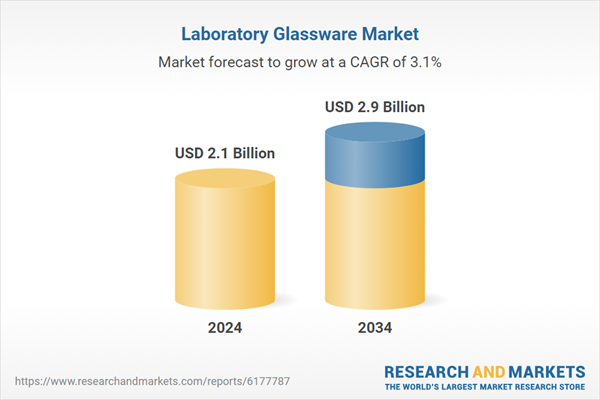Market expansion is fueled by the growing pace of R&D activities and the rise in diagnostic laboratory establishments across regions. Laboratory glassware serves as an essential element in scientific research, diagnostics, and industrial processes by offering chemically inert and highly accurate tools for sample measurement, preparation, and analysis. This glassware, ranging from borosilicate to quartz and specialty-treated varieties, is specifically engineered to resist thermal shock, chemical corrosion, and contamination, making it ideal for both high-throughput research and advanced analytical applications.
Governments worldwide continue to prioritize investment in science, technology, and innovation, supporting public and private laboratories through academic grants, infrastructure upgrades, and scientific collaborations. These initiatives are driving greater demand for reliable glassware across multiple disciplines. Beakers, flasks, pipettes, and similar lab essentials have become foundational components in labs, especially as precision in experimentation and reproducibility become increasingly critical to scientific outcomes. As the global research landscape evolves, laboratories are equipping themselves with higher-quality and more durable glassware to meet rising performance expectations.
In 2024, the pipettes segment held a 30% share, underscoring their critical role in ensuring accurate and repeatable liquid handling across academic, biotech, and pharmaceutical settings. Their ergonomic designs, high precision, and reproducibility make them indispensable tools in quantitative analysis and routine lab procedures. Pipettes are widely used for their ability to maintain consistency in experiments, especially in high-throughput environments that demand tight control over sample preparation and dosage accuracy.
The borosilicate glass segment is expected to grow at a CAGR of 3.4% throughout 2034. Its superior thermal and chemical resilience makes it ideal for laboratory environments where heating, cooling, or exposure to reactive substances is common. Unlike traditional glass, borosilicate materials offer exceptional durability, allowing researchers to perform complex experiments without risking equipment failure due to temperature changes or chemical reactions. This type of glass has become the standard for high-performance lab tools such as flasks, beakers, and culture vessels.
United States Laboratory Glassware Market was valued at USD 754.9 million in 2024. North America maintains a stronghold in this space due to its established research infrastructure, advanced industrial applications, and emphasis on sustainable and precise laboratory operations. Both institutional and industrial laboratories in the region use high-quality glassware for a wide range of tasks, including diagnostic testing, analytical research, quality assurance, and production control. Regulatory compliance plays a significant role in this region, with many labs adhering to detailed standards involving environmental factors, equipment markings, and measurement accuracy as enforced by federal authorities and research institutes.
Key players shaping the competitive landscape of the Global Laboratory Glassware Industry include Hamilton, TECHNOSKLO, BELLCO, SARTORIUS, Crystalgen, Thermo Fisher Scientific, Eppendorf, Gerresheimer, METTLER TOLEDO, CORNING, DWK LIFE SCIENCES, Glassco, BOROSIL Scientific, Chemglass Life Sciences, and Merck. These companies are actively involved in innovating new product lines while maintaining high standards of quality and durability. Top manufacturers in the laboratory glassware market are focusing on multiple strategies to strengthen their market presence. Product innovation remains a priority, with companies investing in advanced materials and ergonomic designs to cater to the growing demand for high-performance glassware. Firms are expanding their global distribution networks and establishing partnerships with research institutions and universities to enhance product accessibility. Many players are also emphasizing sustainability, incorporating recyclable and eco-friendly materials in their glassware offerings.
Comprehensive Market Analysis and Forecast
- Industry trends, key growth drivers, challenges, future opportunities, and regulatory landscape
- Competitive landscape with Porter’s Five Forces and PESTEL analysis
- Market size, segmentation, and regional forecasts
- In-depth company profiles, business strategies, financial insights, and SWOT analysis
This product will be delivered within 2-4 business days.
Table of Contents
Companies Mentioned
The companies profiled in this Laboratory Glassware market report include:- BELLCO
- BOROSIL Scientific
- Chemglass Life Sciences
- CORNING
- Crystalgen
- DWK LIFE SCIENCES
- Eppendorf
- Gerresheimer
- Glassco
- Hamilton
- Merck
- METTLER TOLEDO
- SARTORIUS
- TECHNOSKLO
- Thermo Fisher Scientific
Table Information
| Report Attribute | Details |
|---|---|
| No. of Pages | 135 |
| Published | September 2025 |
| Forecast Period | 2024 - 2034 |
| Estimated Market Value ( USD | $ 2.1 Billion |
| Forecasted Market Value ( USD | $ 2.9 Billion |
| Compound Annual Growth Rate | 3.1% |
| Regions Covered | Global |
| No. of Companies Mentioned | 16 |









